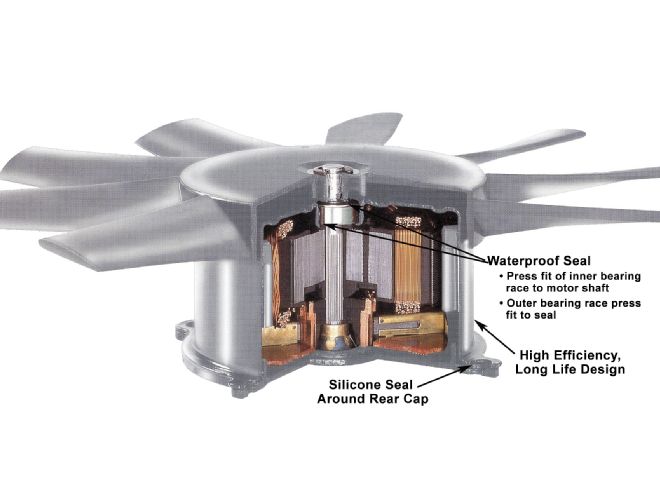
There's nothing worse than hitting the road in your mean machine and overheating. Smiles become frowns and steamy, boiling torrents douse the tarmac as your baby bleeds to death on the side of the road. To avoid the embarrassment, you need a capable cooling system, one that can dissipate excess engine heat efficiently regardless of traffic speed, altitude, load, or ambient temperature. New cars from the factory spend months at the manufacturer's proving grounds long before release to ensure adequate engine protection in any conceivable situation.
But once these cooling systems spend a few years in service and become partially clogged by inevitable mineral formations, or are subjected to a highly modified engine package, it's time for a rethink. Remember, the liquid-cooled internal combustion engine relies exclusively on water, or water-based fluid, and airflow to remain cool.
It works like this: The engine block, heads, and (usually) intake manifold are cast with hollow internal passages that form a closed circuit within the assembled engine. This circuit is oriented so that an external pump (electric or beltdriven mechanical) pushes liquid coolant first past the outside walls of the cylinder bores, then up into the cylinder heads and back out again to the radiator core. Gaskets, O-rings, and thin-film RTV seals prevent leaks at junction points.
The radiator itself is made up of two tanks (top and bottom or side and side, depending on make). These tanks each have a hose fitment nipple that accepts a large-diameter transfer hose. One hose (usually the lower) runs into the engine, the other runs from the engine back to the remaining tank. The hoses are made of flexible rubber or silicone so the engine is free to vibrate and move without fracturing rigid fluid tubes.
Between the two radiator tanks are a large number of hollow tubular members through which the coolant flows as it makes its way from one tank to the other. This structure is called the radiator core. Between each tube, zillions of thin metal strips are arranged so as to increase the surface area of the core. As air passes through the core due to vehicle movement or the cooling fan, heat is transferred from the metal surfaces into the passing airstream.
A thermostat is located (typically) at the junction of the cylinder head and upper radiator return hose. Within the thermostat, a heat-sensitive valve opens and closes at a certain setting to restrict coolant flow enough to keep coolant temperature in an efficiency zone ranging from 180 to 220 degrees Fahrenheit (depending on application).
A vital part of the system is a mechanical or electric pump to set the liquid coolant into motion. Like the heart in your chest, this pump never stops pumping so long as the engine is running. As the pump forces the liquid coolant through the many hollow voids within the engine structure, it comes into direct contact with heated metal surfaces, where a significant portion of the heat is immediately absorbed by the liquid. Since the liquid is constantly moving, this process of heat transfer is never ending—so long as the engine is running and the coolant pump is operating.
As for the specific construction of these cooling passages, it is beyond the scope of this article to describe the how's and why's of the science that goes into determining how large—or small—each void must be. The same holds true for the sizing of the radiator core's surface area and thickness. But one look at the 19-inch-wide, two-row radiator fitted to a 1968 Plymouth Slant Six Belvedere and then at the 26-inch-wide, three-row radiator installed on a same-year Hemi Road Runner speaks volumes about the factory's understanding of the need to match the radiator to the engine and drive line. One size does not fit all applications.
So now that we have a basic grasp of what the gurgling green (or red on newer cars) fluid visible when you unscrew the radiator cap is going through, lets have a chat with Chuck "CJ" Clayton from Maradyne High Performance Fans.
CC: When do you know its time to step up to an auxiliary cooling fan?
CJ: One of the biggest benefits you'll get from an electric fan is improved low-speed cooling. If you're idling along at between 900 and 1,200 rpm, the pulley-driven mechanical fan really isn't spinning fast enough to move a lot of air. The car's ground speed is less than 35 mph and you aren't going to get much air movement through the radiator core. So this is where an electric fan has the advantage.
CC: How about the parasitic drag of a mechanical fan?
CJ: Any time you can take rotating mass off the engine, you've accomplished a gain. It takes about 5 hp to run an electric fan. Remember, the more electric accessories you ask the alternator to run, the harder the alternator pulley is to turn. This resistance to rotation can be measured and comes out to about 5 hp needed to run a typical cooling fan's electric drive motor. By contrast, dyno tests have shown pulley-mounted mechanical fans to consume twice as much horsepower.
CC: The Maradyne catalog seems to offer a fan, or fans, for virtually any application. Within the Champion, Mach, Jetstream, Challenger, and Pacesetter fan lines, flow ratings ranging from 375 to 2,315 cfm are possible. How do you know which unit to choose?
CJ: CFM with a cooling fan is not like cfm with a carburetor. You cannot put too much fan on, so bigger is better—as long as the charging system can handle the demand. A single fan system will demand between 10 to 30 amps.
CC: On a typical standard muscle-car-era 12-volt electrical system, how much reserve capacity is there to run things like electric cooling fans?
CJ: I tell people not to spend money until they have to. On say, a stock 1968 4-4-2, the standard 40-amp alternator is responsible for running the lights, turn signals, heater fan, radio, and not much else. But when a customer added the A/C system, Oldsmobile automatically included the 55-amp alternator knowing its air-distribution fan, electric clutch, and related draws would overtax the standard alternator. Hot rodders need to think the same way. On most cars, there is usually enough reserve capacity to add a single electric fan without the need for an upsized alternator. I'd even suggest it could run a dual-fan system. Try it out and see before spending money on a higher-output alternator.
CC: What are the signs of an inadequately sized alternator?
CJ: An overworked alternator will put the ammeter needle (if so equipped) into the charging zone more than it did before the additions were made. Other symptoms will be "twitches" in headlamps brightness when other electrical components are activated. That's a sign the charging system is working close to—or at—full capacity. When I see this, I always tell customers not to mess around and to step up to the largest alternator available for their application.
CC: Generally speaking, does your average muscle-car customer need to upsize his alternator automatically?
CJ: Generally speaking, I find that most of my customers have already upgraded their alternators as part of the vehicle restoration/customization process. About 8 or 9 out of 10 Maradyne customers have already installed an upgraded alternator, so the problem is already solved by the time they call us for a fan. There are numerous aftermarket alternators rated at 63 to 200 amps available for just about every application.
CC: With electric fans available in pusher and puller configurations, what's your preference?
CJ: I tell my customers the puller-type fan is always better because it doesn't obstruct natural airflow. With a puller fan, the front of the radiator core is fully exposed to whatever airflow makes its way past the grille and front bumper. This is the ideal situation. Any time you hang something in front of the radiator core, you have obstructed the natural airflow. If you take a 16-inch axial fan and put it in front of the radiator core (as in a pusher-type installation), the incoming air is going to hit the 4-inch-diameter electric motor cap. When the incoming air stream hits that 4-inch cap, it is deflected in any number of ways, none of which involve the passing of air through the radiator core. That's not good. This is just one of many reasons why the fan ideally needs to be mounted between the radiator and engine.
CC: But what happens to the stock mechanical fan when you insert the electric fan in this tight space?
CJ: We do offer some thin fans that are trim enough to coexist with the stock mechanical fan, but for the most part, our installations require the elimination of the mechanical fan entirely. There's typically not enough space for both.
CC: How do you reassure old-schoolers who might not want to trust their engine's cooling needs to an electric fan unit?
CJ: This is rare, as most customers rightfully trust the modern electrical components we use. And once these guys experience the reliability of and electric fan assembly, they're sold for life. Remember, virtually every new car on the road relies 100 percent on an electric fan. The same holds true for fuel pumps. I can't remember the last new car to use a mechanical fuel pump. Beyond that, when a stock mechanical fan is coupled to an electric fan, we have to ask what kind of turbulence are we creating? What is that air doing when moved by two different fan blades at different speeds?
CC: How about mounting the fan/motor assembly, what's the best method?
CJ: You want the blades as close to the radiator as possible without contact. Our single-fan units come with a spacer that puts about ¼-inch between the moving blades and radiator tubes. This is ideal. You can space it out a little farther, but the farther you move out, the less air the fan is going to pull through the radiator. This is because the gap you've created will pull heated, undesirable ambient air from inside the engine bay.
CC: Any advice for those diehards who insist on running the stock mechanical fan behind the radiator, but with your fan (or fans) mounted in front of the radiator?
CJ: In these cases, I tell them to run the fan all the time and not in a thermostatically triggered mode. This is because there is no way to determine what effect the stationary fan blades might be having on the moving air between the grille and radiator core. Is the electric motor cap acting as a blocking cone and magnifying the stagnant zone? Is it interacting with adjacent under hood structures and causing as much harm as good? By activating the fan motor and spinning the blades, the threat is negated because the air is moving into the radiator core.
CC: How about radiator surface area and knowing where to position an electric fan on it, any advice?
CJ: The ideal spot is right in the middle of the core. Here, any cooling effect is evenly radiated out, down, and to the sides in an even fashion. If you put the cooling-fan unit in the lower-right corner (assuming you had the room), all of the cooling effect will be concentrated in the lower-right corner, while the rest of the core will run hotter. Placing the cooling unit in the center allows the cooling effect to be even 360 degrees around the center of the fan motor.
CC: When mounting an electric fan unit, what's the best method?
CJ: There's more to mounting a cooling fan assembly than meets the eye. Not only do you have to consider the need to pull the shroud as close to the core as possible to prevent suction leaks, you also have to account for the weight of the unit and the torque surge when the motor engages. I tell people who want to mount a 225-watt, 16-inch fan directly to their radiator core with pull-ties, "I don't know if it is going to take three months or two years, but with 5 pounds of fan unit hanging off the radiator tubes, you're asking for something they weren't designed to do. There will be problems eventually." So while our kits all ship with heavy-duty nylon plastic pull-tie mounts, we also offer custom mount kits that use the outer radiator shell to support the unit. We suggest these custom mounts for any fan over 11 inches.
CC: To that point, what are the sizes offered by Maradyne?
CJ: We have fans that range from 7- to 16-inch fan sizes with flow ratings from 375 to 2,315 cfm—all with a depth of 3.19 inches or less; the Champion Series offers a low-profile, push-pull fan in a quiet, reversible S-blade design that eliminates vibration contact and increases airflow. The 10-inch fan being popular with owners of Tri-Five Chevrolets. These guys are the ones most likely to retain the stock mechanical fan and put one or two of our 10-inch fans in front of the radiator core as pushers. This application has enough space to accept plenty of fans, and they're needed with that tall, narrow GM radiator and a healthy big-block.
CC: Can the same electric-fan unit push and pull, or is there something different inside each type that locks it into being a puller or a pusher for its entire life?
CJ: All of our fans, except for about four or five part numbers, are reversible. It's a simple two-step process to convert our fans from pusher to puller—or visa-versa. First, you pull the fan off the drive spindle and reverse it so the blades cut into the air differently, then you reverse the polarity of the electric feed wires. It's as simple as that. But you have to make both changes or the fan blades won't do what they were designed to do.
CC: How about shrouding?
CJ: We always recommend a shroud, as it provides a more focused airflow through the radiator core. Maradyne high-performance fans are made from all glass-filled nylon construction and feature concentric rings. This prevents the blades from flexing as they achieve maximum rpm. And for smooth operation, a critical factor that protects sometimes delicate radiator tank-to-tube unions from damage, all fans are dynamically balanced.
CC: If a shroud is not possible due to space limitations, what's the alternative?
CJ: Our Champion, Challenger, and Pacesetter fans have a circular footprint that presents a smaller forced airflow zone than the enclosed square or rectangular footprints of the Mach and Jetstream product lines. The more compact circular footprint is still very effective, and I have personally seen a single 16-inch M162K keep a 550hp Chevy-small-block-powered street car cool with no shroud and no mechanical fan mounted to the water-pump pulley.
CC: Are all shrouds created equal?
CJ: No, a poorly designed shroud can actually work against you by creating a wind wall that prevents heated air from escaping. This can actually trigger overheating. That said, shrouds focus the airflow and where space allows them, they're to be used.
CC: How about the fan control system, do you recommend automatic (thermostat controlled) or manual (driver activated) on/off switches?
CJ: The industry has had more than 30 years to perfect the automatic switches we use and I trust them with my cars. That said, there are certain situations where it is desirable to have a manual override switch. Drag racers, for instance, like being able to switch off the fan during a race to reduce the load on the alternator for increased power to the slicks. On the other side of the coin, lets say your buddy borrows the hot rod and doesn't know to switch on the cooling fan when sitting in traffic. This is where an automatic activation system is desired.
CC: In a thermostatically controlled system, where is the best place to locate the temperature probe?
CJ: I like to position the probe into the fins of the radiator core near the hot-water entry hose location. This way, as soon as the hot water leaving the top of the engine enters the core, the temperature probe detects it immediately and triggers the cooling fan sooner than later. All of this is clearly spelled out in the Maradyne installation booklet.
CC: Do you have any advice about temperature gauges?
CJ: In the past month, I've had to tell four muscle-car customers it was time to add an auxiliary temperature gauge. They called me saying their factory gauges were reading "halfway" and I had to answer that there is no way to know what the true temperature is with this basic equipment. A mechanical coolant temperature gauge is cheap insurance against a costly engine meltdown. If the car is too pure and a gauge is not acceptable, a quality laser-guided temperature gun is a good alternative. In the end, you really have to have solid coolant temperature information.
Thicker radiator cores generally cool better than thinner cores. But don't assume that a stack of four, five, or six rows of small-diameter cooling tubes is better than an equally thick core consisting of two or three oval-shaped tubes.
Radiator tubes come in many shapes and sizes. The most efficient tubes have a cross-sectional form resembling an ellipse (squashed oval). Elliptically shaped tubes present the largest cooling surface. A well-designed two-row radiator with large, ovoid tubes can cool just as well as a same-size four-row using smaller tubes.
The heat-conducting properties of copper and aluminum radiator cores are almost equal. Advances in adhesive bonding technology gave rise to the modern plastic/aluminum radiators used in nearly every new car on the road today. Better still, aluminum radiators weigh half as much as their old-school brass/copper counterparts.
Cross-flow radiators are generally shorter and wider than conventional downflow radiators. This lets body stylists design lower, sleeker hood lines. It was a major reason why GM transitioned to cross-flow radiators on its 1968 midsize A-body (Chevelle, GTO, and so on) models.
Cross-flow radiators are available with divorced-section cores that employ dead zones between the heat exchangers. Known as multi-pass cores, they can run 10 to 20 degrees cooler than a single-pass radiator with the same core size.
When trapped in a pressurized environment at sea level, the static boiling point of water increases by approximately 3 degrees for every added pound of pressure. So with a radiator cap designed to maintain 15 psi, boil-over is bumped up from 212 to 257 degrees.
The presence of 50 percent ethylene glycol (antifreeze) raises the static boiling point about 10 degrees versus straight water. At sea level and with no pressurization, the static boiling point of the 50/50 glycol/water mix is 222 degrees; at 15 psi, boiling occurs at 267 degrees.
The ideal coolant temperature range for a typical non-emission-controlled V8 engine is 160 to 200 degrees, with 180 being the sweet spot. Temperatures below 160 encourage the formation of acidic crankcase compounds. Temperatures above 200 can degrade oil viscosity and reduce the boil-over safety margin.
Modern emissions-controlled vehicles are intentionally configured to run at temperatures as high as 240 degrees. They incorporate metal alloys, internal clearances, piston-ring design, lubricants, and other specifics to ensure long life, despite the elevated heat.
Excessively high radiator cap pressure levels can burst tank/tube seams on radiators designed to run at a lower pressure. Always check the manufacturer's recommendations.
Straight water has the best thermal conductivity, but with its 32-degree freezing point, cracked blocks and heads are almost a sure thing if overnight ambient temperature drops below freezing. A 50/50 mix of glycol antifreeze and water ensures safety, but might get you booted from the dragstrip. Leaked 50/50 is slippery and difficult to clean up.
Racers who insist on running straight water should seek distilled water for its lack of minerals. Minerals increase water's electrical conductivity and the threat of electrolysis. That said, as soon as the "pure" water contacts the iron and aluminum inside your mill, it's contaminated and ready to conduct. The only salvation comes from frequent fluid changes and the use of a quality rust inhibitor additive.
Running without a thermostat doesn't always—but can—trigger excessively rapid coolant flow and the formation of bubbles through cavitation. Fizzed coolant cannot extract as much heat as solid liquid and overheating may result.
On the other side of the coin, thermostats have been known to get stuck in the closed position, triggering catastrophic overheating. Running without a thermostat generally reduces overall coolant temperature. Your car's heater will not provide as much warmth—if you happen to live in a cold climate and care.
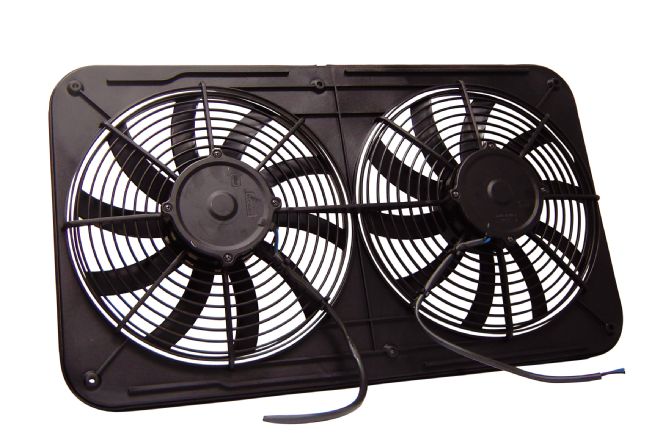
1 Due to their rectangular footprint, tandem fans are best suited to low and wide cross-flow radiators.
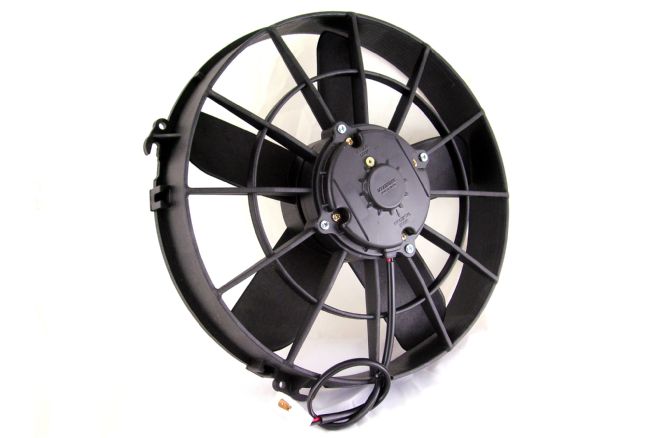
2 Single-fan units are best suited to the upright surface of downflow radiators.
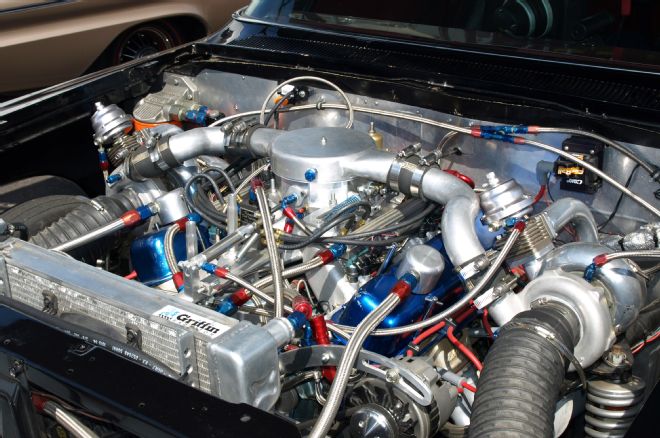
3 The builder of this twin-turbocharged Pontiac relies on an aluminum Griffin cross-flow radiator to keep things cool. Minimal space between the radiator and engine accessory drive forced the use of a single pusher-type electric fan (barely visible between the radiator wall and core).
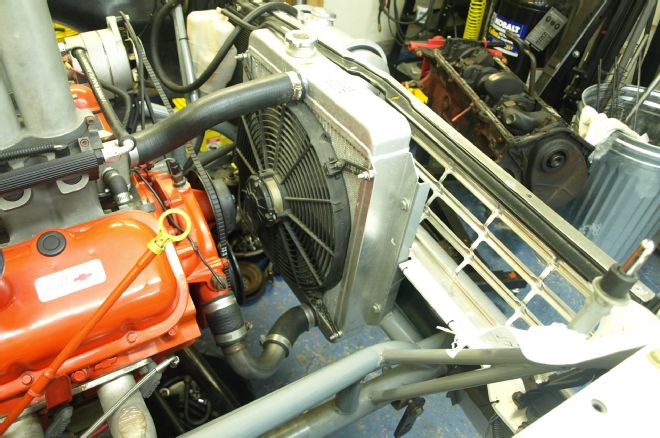
4 Here's proof you don't need a huge radiator to keep things cool. Built to participate in the 2001 Hot Rod Power Tour (didn't happen), this 17x19-inch Griffin radiator kept your author's street- and strip-driven, 502 big-block-powered, altered-wheelbase 1963 Nova cool at all times. Its 2-3/4-inch-thick core is comprised of two rows of high-efficiency oval tubes. The single electric fan was set to kick on at 180 degrees. This setup easily maintained 190 degrees, but would creep up to 210 during extended 80-mph freeway cruising. Slowing to 70 mph brought it back to 190. This package loved stop-and-go traffic jams.
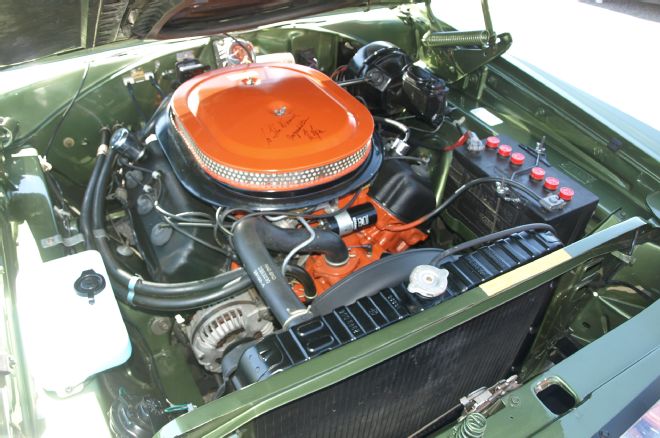
5 Though many claim cross-flow radiators are superior, Chrysler successfully used copper and brass downflow cores on just about everything built before 1980. Street Hemi applications got massive 26-inch-wide cores with three rows of tubes and are legendary for maintaining 180 degrees at all times. Note the stock plastic fan shroud encircling the clutch-activated, viscous-drive, seven-blade mechanical fan. Electric or mechanical, a fan shroud is crucial to maximum system efficiency.
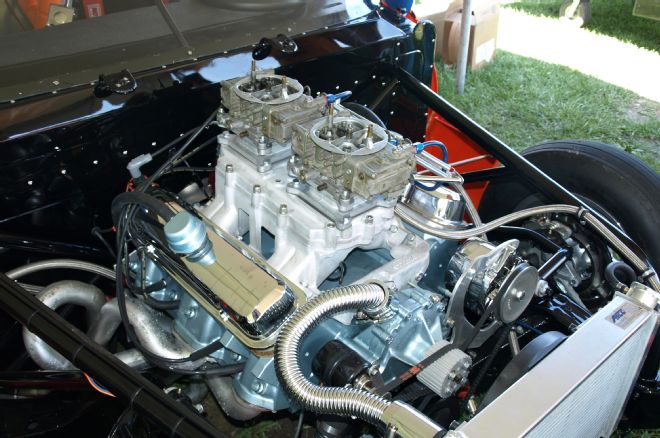
6 Though never exposed to highway travel, drag machines like Arnie Beswick's Righteous Judge 1969 GTO Pro Stock match-race replica need effective cooling systems so they're ready for the next round of eliminations—sometimes mere minutes after the last pass. For his modernized restoration, a huge Afco cross-flow radiator is teamed with a single electric fan. The 428-based mill wears a 1963 bathtub tunnel ram and cranks easy 9.0s.
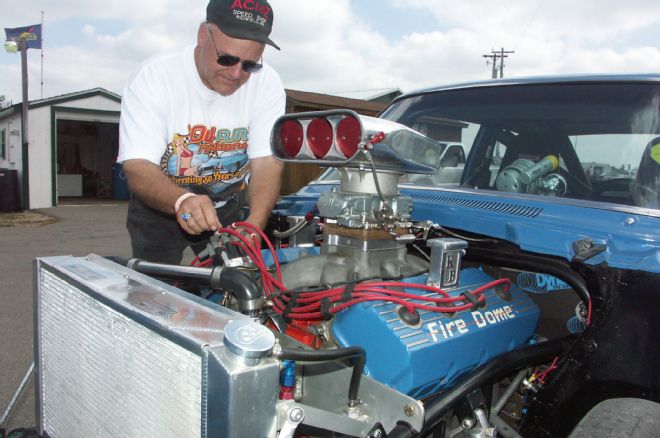
7 This race-only 528 Hemi-powered Rambler relies on a massive aluminum cross-flow radiator with no cooling fan. Built for quarter-mile sprints, an electric motor spins the water pump to keep the coolant in motion. This arrangement is overkill.
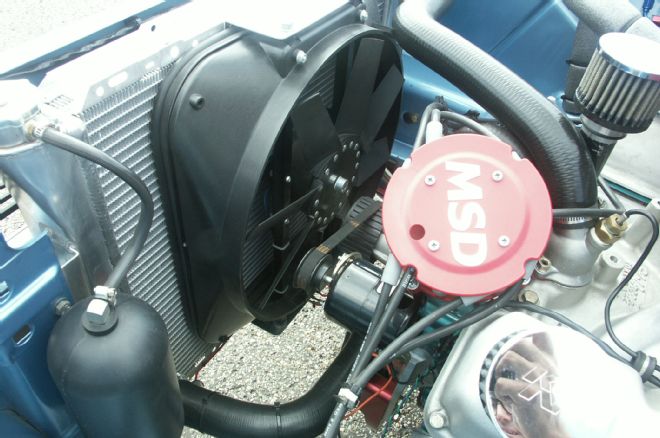
8 The unitized construction of most electric fans makes for easy, quick installation. The integrated shroud and rubber perimeter seal concentrate airflow through the core for maximum efficiency. That said, heavier units like this must be attached with external mounts rather than via through-straps, which can stress the core-to-tank unions and cause leaks.
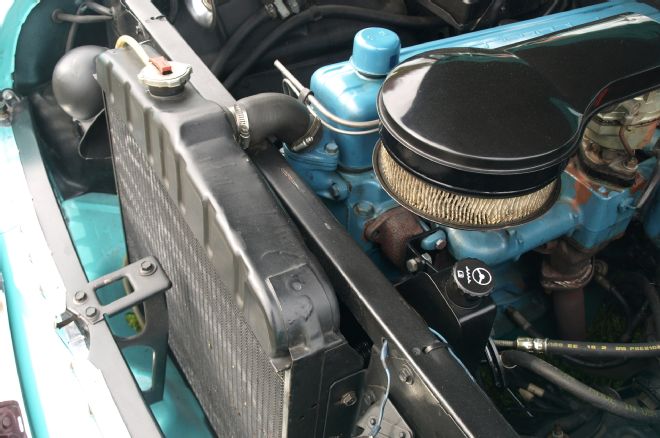
9 This stock 1955 Chevy illustrates a classic radiator and fan packaging problem. The length of the Stovebolt six forced GM to mount the radiator ahead of the radiator core support. With the optional 265 small-block, the shorter length of the V8 block allowed GM to put the radiator behind the core support. Hot rodders today often mount the radiator in the outboard (six-cylinder) position, junk the mechanical fan, and install a huge electric puller fan. This system will keep a 572 tall deck big-block cool in Arizona.